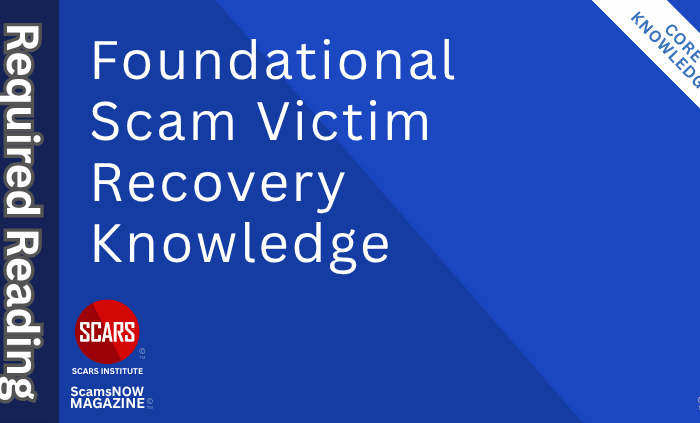
Difficult Days – a Guide for Scam Victims Navigating Betrayal Trauma
Weathering the Emotional Storms of Scam Victim Recovery: a Path to Resilience for Betrayal Trauma Survivors
Primary Category: Scam Victim Recovery Psychology
Author:
• Vianey Gonzalez B.Sc(Psych) – Licensed Psychologist, Specialty in Crime Victim Trauma Therapy, Neuropsychologist, Certified Deception Professional, Psychology Advisory Panel & Director of the Society of Citizens Against Relationship Scams Inc.
• Tim McGuinness, Ph.D., DFin, MCPO, MAnth – Anthropologist, Scientist, Polymath, Director of the Society of Citizens Against Relationship Scams Inc.
Author Biographies Below
About This Article
When you have difficult days, betrayal trauma can turn minor setbacks into intense emotional storms marked by fear, anger, shame, and hypervigilance. Effective coping begins with disconnecting from immediate triggers, naming emotions, and using mindfulness and breathing to restore calm. Allowing feelings to rise and pass without judgment reduces overwhelm. Perspective returns through grounding, reframing language, and viewing thoughts as temporary. Mental boundaries protect limited energy, while short timeouts and physical distance prevent escalation. Clear thinking improves when decisions are delayed, events are evaluated for real impact, input is sought from trusted people, and reflections are captured in writing. Self-compassion, not self-blame, supports steady recovery. With practice, these skills help survivors regain control, make safer choices, and build resilience over time.
Note: This article is intended for informational purposes and does not replace professional medical advice. If you are experiencing distress, please consult a qualified mental health professional.

Weathering the Emotional Storms of Scam Victim Recovery: a Path to Resilience for Betrayal Trauma Survivors
Navigating Difficult Days: A Guide for Those Healing from Betrayal Trauma
Everyone experiences difficult days when things feel overwhelming and triggering, but for those who have endured betrayal trauma, these days can be particularly challenging.
A small setback or trigger can escalate into a storm of emotions, leaving you feeling like you’re drowning in a sea of fear, anger, and despair. It’s important to remember that these reactions are a normal part of your healing journey – a normal part of recovery, and with the right tools, you can navigate these difficult days with greater ease and resilience.
Betrayal trauma, whether it stems from a romantic partner, a friend, or a family member, can leave deep psychological scars. These scars are not just metaphors; they represent the profound psychological injury, the impact of having your trust shattered and your sense of security compromised. On a difficult day, these scars can feel raw and painful, as if the betrayal is happening all over again. You might find yourself reliving the moment of realization, questioning your judgment, and wondering how you could have been so wrong about someone. Shame, blame, and guilt can resurface with a vengeance.
The intensity of these emotions can be overwhelming. They can color your perception of the world, making even minor inconveniences feel like insurmountable obstacles. It’s as if your brain is on high alert, hyperactivated again, constantly scanning for threats and dangers, even when none exist. This heightened state of alertness is a natural response to trauma, but it can also be exhausting and disorienting.
In these moments, it’s very important to try to remember that you are not alone in your struggles. Many others have walked this path and have found ways to manage their emotions and regain a sense of control. This quick guide is designed to provide you with practical tools and strategies to help you navigate difficult days. By understanding your emotions, setting boundaries, and maintaining perspective, you can create a more balanced and fulfilling life, even in the face of challenges.
Remember, your recovery, your journey to healing is unique, and every step you take is a testament to your courage and strength. Be patient with yourself, celebrate your progress, and know that you have the power to create a life filled with hope, joy, and fulfillment. As you continue on your path, remember to embrace self-compassion and to trust in your ability to heal. Difficult days will come and go, but your resilience and your spirit will endure. You are more than your past, and your future is bright with endless possibilities.
Understanding the Storm
On a difficult day, you can find yourself suddenly engulfed in a whirlwind of emotions. A minor inconvenience, a reminder of past betrayals, or even a seemingly innocuous comment can act as a trigger, setting off a cascade of intense feelings. These emotions can be so overwhelming that they seem to consume your entire being, making it hard to think clearly or respond effectively. It’s as if your brain is on high alert, constantly scanning for threats and dangers, even when none exist.
This heightened state of alertness is a natural response to trauma. Your body and mind are wired to protect you, and when you’ve experienced betrayal, that protection can sometimes feel like a constant state of siege. It’s important to acknowledge that this response is valid and that it serves a purpose, even if it feels uncomfortable or overwhelming.
Disconnecting from the Trigger
When you feel the storm of emotions rising, the first step is to disconnect from the immediate trigger. This doesn’t mean ignoring your feelings, but rather acknowledging them without letting them control you. Imagine your emotions as clouds passing through your mind. You can observe them, name them, and let them move on without getting caught up in their swirl.
For example, if a certain thought or memory is causing you distress, try labeling it. Name it. Say to yourself, “I am feeling anxious because of this memory.” By naming the emotion, you create a small but significant distance between yourself and the feeling. This distance allows you to observe your emotions rather than being completely engulfed by them.
Practicing mindfulness can be a powerful tool in this process. Mindfulness involves focusing on the present moment without judgment. You can start by taking a few deep breaths, feeling the sensation of the air entering and leaving your body. This simple act can help ground you and create a sense of calm amidst the emotional storm.
We have many mindfulness tools here on ScamsNOW – click here to see some of them.
Letting Emotions Flow Through
Emotions, like water, need to flow to dissipate. Trying to repress them just makes the impact greater. When you’re caught in on difficult days, try to create a mental space where these emotions can move through you without getting stuck. As we say, “Name it, don’t shame it or blame it.” This might involve deep breathing, meditation, or simply taking a moment to sit quietly and feel your feelings without judgment.
Remember, emotions are not right or wrong; they simply are. By allowing yourself to feel without blaming or shaming, you give your emotions the space they need to pass through and eventually subside. It’s okay to cry, to shout, or to simply sit in silence. Whatever you feel is valid, and giving yourself permission to experience these feelings can be incredibly liberating.
One technique that can be helpful is to visualize your emotions as physical entities. Imagine them as colors or shapes moving through your body. As you breathe, picture these emotions flowing out with each exhalation. This visualization can help you feel more in control and less overwhelmed by your feelings.
Maintaining Distance and Perspective
Maintaining a sense of distance and perspective during difficult days can be challenging, but it’s a critical skill for managing your emotional well-being. One effective strategy is to imagine yourself as an observer, watching your thoughts and feelings from a distance. This mental shift can help you see your emotions as temporary states rather than permanent conditions. Try using the ‘RAIN’ technique.
You might also find it helpful to engage in activities that ground you in the present moment. This could be as simple as focusing on your breath, feeling the sensation of your feet on the ground, or engaging in a task that requires your full attention, like cooking or gardening. By anchoring yourself in the present, you can create a buffer between yourself and the overwhelming emotions of the past.
Another technique is to reframe your thoughts. Instead of saying, “I’m having a bad day,” try saying, “I’m having a challenging day.” This small shift in language can help you see the situation as a temporary challenge rather than a defining characteristic of your day.
Setting Mental Boundaries
As an uncomfortable event unfolds, setting mental boundaries can help protect you from prolonged emotional distress. This involves recognizing when you need to step back and take a break, even if the situation hasn’t fully resolved. It’s okay to say “no” to further engagement, to take a timeout, or to seek support from someone you trust.
Think of your emotional energy as a finite resource. On difficult days, it’s important to conserve this energy by setting boundaries that allow you to recharge and regain your composure. This might mean limiting your exposure to stressful situations, delegating tasks to others, or simply taking time for yourself to rest and recover.
Stop and take a break. If it is still a problem after that, then you will be better prepared to make the sound decisions you need to deal with it.
Practical steps for setting boundaries include:
- Identify Your Limits: Recognize when you’re reaching your emotional capacity and need to step back.
- Communicate Clearly: Let others know that you need some space or time to yourself.
- Create Physical Distance: If possible, remove yourself from the triggering environment.
- Prioritize Self-Care: Engage in activities that nurture your well-being, such as reading, taking a bath, or going for a walk.
Evaluating the Event
When you’re in the midst of a difficult day, it can be hard to see the event for what it truly is. Emotions can distort your perception, making small issues seem insurmountable and temporary setbacks feel like permanent defeats. To gain a more balanced perspective, try these steps:
- Take a Step Back: Give yourself some physical and emotional space from the situation. This might mean taking a walk, going to a quiet room, or simply pausing your activities for a few moments.
- Name the Emotions: Identify and label the emotions you’re feeling. Are you angry, afraid, sad, or something else? Naming your emotions can help you understand their source and intensity.
- Assess the Impact: Consider the real impact of the event on your life. Is it a minor inconvenience, a temporary setback, or a significant challenge? Try to separate your emotional reaction from the actual consequences.
- Compare to Past Experiences: Reflect on similar events in your past. How did you handle them, and what did you learn? This can provide a sense of context and remind you of your resilience.
- Put It Away for Now: If the emotions are too intense to manage in the moment, it’s okay to put the event aside and revisit it later. You can tell yourself, “I’ll deal with this when I’m feeling calmer and more centered.”
Making Better Decisions
Difficult days do cloud your judgment, making it hard to make clear, rational decisions. To ensure you’re making the best choices for yourself, try to delay major decisions until your emotions have subsided. Give yourself time to process your feelings and gain a clearer perspective.
You might also find it helpful to seek input from trusted friends or family members. The simple act of speaking about the challenge can help you reduce its impact, and help to clarify what you might do to resolve it. Sometimes, an outside perspective can provide valuable insights and help you see the situation more objectively. Remember, it’s okay to ask for help, and doing so doesn’t diminish your strength or resilience.
Practical steps for making better decisions include:
- Delay Important Choices: Wait until you’re feeling calmer and more centered before making significant decisions.
- Seek Outside Input: Talk to trusted friends, family, or a professional counselor for an outside perspective.
- Write It Down: Journaling your thoughts and feelings can help you process them more clearly and make more informed decisions. By the way, did you know that the SCARScommunity.org support portal has a real, private, and confidential journal built in, free for all members.
Embracing Self-Compassion
Finally, be kind to yourself. Difficult days are a normal part of life, and they don’t define your worth or your progress. Treat yourself with the same compassion and understanding you would offer to a dear friend. Acknowledge your feelings, validate your experiences, and remind yourself that you are doing the best you can.
Remember, the betrayal from the scam was not your fault.
Healing from betrayal trauma is a journey, and difficult days are a natural part of that journey. By developing the skills to survive these days with greater ease and resilience, you can help you create a more balanced, fulfilling life, even in the face of challenges. Remember, you are stronger than you know, and you have the capacity to heal, grow, and thrive.
Self-compassion is not just about being gentle with yourself; it’s about cultivating an inner warmth and understanding that can guide you through the darkest times. Compassion-focused therapy, for instance, emphasizes the importance of replacing self-blame with self-kindness, which is crucial for healing 1. This approach helps you recognize that your emotions and reactions are valid and that you deserve support and kindness.
Practicing self-compassion can also involve engaging in activities that nurture your well-being. This might include mindfulness practices, meditation, or even simple acts of self-care like taking a relaxing bath or going for a walk in nature. These activities can help you connect with your emotions and provide a sense of calm and clarity amidst the chaos.
Plus, self-compassion is about accepting your current state without judgment. It’s okay to have off days, to feel overwhelmed, or to struggle with your emotions. These experiences are part of the healing process and do not diminish your strength or resilience. By embracing self-compassion, you create a safe space within yourself to process your feelings and move forward.
Incorporating self-compassion into your daily life can also involve setting boundaries and prioritizing your needs. This might mean saying “no” to commitments that add unnecessary stress or taking time for yourself when you need it. It’s important to remember that your healing is a priority, and that taking care of yourself is not a luxury but a necessity.
Additionally, surrounding yourself with supportive people can enhance your practice of self-compassion. Engaging with individuals who uplift and validate your feelings can provide a sense of community and understanding that is invaluable during difficult times. This support network can remind you of your worth and help you navigate the challenges of healing.
Remember, self-compassion is a skill that can be developed over time. It’s a journey of learning to treat yourself with the same kindness and understanding you would offer to someone you love. As you cultivate this inner warmth, you will find that you are better equipped to handle the ups and downs of life, and that your capacity for healing and growth is greater than you ever imagined.
In the words of Kristin Neff, a leading researcher on self-compassion, “Self-compassion involves being warm and understanding toward ourselves when we suffer, fail, or feel inadequate, rather than being coldly critical and judgmental.” This perspective underscores the importance of embracing self-compassion as a path to healing and personal growth. By treating yourself with kindness and understanding, you can begin to heal from the wounds of betrayal and move forward with renewed strength and resilience.
Conclusion
Difficult days are a part of life, and for those healing from betrayal trauma, they can be especially challenging. But remember, these days do not define you. They are temporary storms that pass, leaving you wiser, stronger, and more resilient. By understanding your emotions, setting boundaries, and maintaining perspective, you can navigate these difficult times with greater ease and grace.
Your journey to healing is unique, and every step you take is a testament to your courage and strength. Be patient with yourself, celebrate your progress, and know that you are not alone. There are people and resources available to support you, and you have the power to create a life filled with hope, joy, and fulfillment.
As you continue on your path, remember to embrace self-compassion and to trust in your ability to heal. Difficult days will come and go, but your resilience and your spirit will endure. You are more than your past, and your future is bright with endless possibilities. Keep moving forward, one step at a time, and know that you are worthy of a life filled with peace, love, and happiness.

Glossary
- Acceptance practice — This refers to choosing to acknowledge difficult feelings and thoughts without trying to fight them. Acceptance helps reduce struggle, which lowers emotional intensity and clears space for practical steps. It does not mean approval of what happened; it means recognizing the current reality to move forward.
- Affect labeling — This means putting feelings into simple words, such as “sad,” “angry,” or “afraid.” Naming emotions reduces their power by engaging the thinking parts of the brain. It creates a small distance that helps a person respond rather than react.
- Anchoring — This is the act of focusing attention on one steady cue, like the breath or the feeling of feet on the floor. Anchoring brings awareness back to the present when emotions surge. It supports calm, clear decision-making during stressful moments.
- Anticipatory anxiety — This describes fear that builds before an event, often worse than the event itself. It shows up around holidays, court dates, or anniversaries. Recognizing it as a forecast, not a fact, helps reduce its grip.
- Assessment pause — This is a brief stop to check safety, needs, and next steps before acting. A pause slows impulsive choices and prevents escalation. It also creates time to ask for support if needed.
- Boundary setting — This means deciding what is and is not acceptable for one’s time, energy, and interactions. Clear boundaries protect limited emotional resources on hard days. They also reduce exposure to triggers and pressure.
- Breathing practice — This is a slow, steady pattern of breaths used to settle the body. Longer exhales signal the nervous system to shift out of high alert. Even one or two minutes can reduce dizziness, trembling, or panic.
- Catastrophizing — This is a thinking habit that jumps to worst-case outcomes. It inflates minor setbacks into crises and drains hope. Catching it early and testing facts helps restore balance.
- Compassion-focused therapy — This is a clinical approach that builds kindness toward self to counter shame and self-criticism. It trains soothing skills and supportive inner dialogue. Many survivors find it reduces blame and eases recovery work.
- Decision deferral — This is the choice to delay major decisions until emotions settle. Postponement protects from regret and allows consultation with trusted people. It is a sign of wisdom, not avoidance.
- Distress tolerance — This skill set helps a person endure intense feelings without harmful actions. It includes grounding, breathing, and short timeouts. The goal is to ride out waves safely until they pass.
- Emotional flooding — This describes a surge of feelings that overwhelms thinking and memory. Flooding can follow triggers, reminders, or exhaustion. Short breaks, hydration, and gentle movement help the wave recede.
- Emotional granularity — This is the ability to distinguish similar feelings, such as irritation versus anger. Finer labels guide better choices for relief. It turns vague upset into specific needs.
- Flashback — This is a sudden re-experiencing of aspects of the trauma, such as images, sensations, or emotions. It feels current but comes from memory. Grounding to present cues helps it fade.
- Grounding techniques — These are simple actions that reconnect attention to the here-and-now, like naming five things seen or touching a cool surface. Grounding lowers dissociation and fear. It is most effective when practiced daily.
- Hyperarousal — This is a body state of high alert after trauma. Signs include rapid heartbeat, tight muscles, jumpiness, and poor sleep. Gentle routines and consistent habits help the system settle.
- Intrusive memory — This is an unwanted thought or image that pushes into awareness. It often appears during stress or fatigue. Labeling it as a memory and returning to an anchor reduces its impact.
- Journaling — This is writing private notes about events, thoughts, and feelings. It organizes experience and reveals patterns that guide recovery. It also preserves progress that is easy to overlook.
- Letting-go ritual — This is a personal act that marks the release of a painful chapter, such as writing and safely disposing of a letter. Ritual offers closure and honors effort. It can be repeated when grief spikes.
- Mindfulness — This is paying attention to the present, on purpose, without judgment. It builds steadiness during emotional storms. Short, regular practice is more helpful than long, rare sessions.
- Observer stance — This is imagining oneself stepping back to watch thoughts and feelings pass by. The stance turns struggle into observation. It helps choices replace impulses.
- Pacing and spacing — This means breaking tasks into small steps and adding rest between them. It prevents overwhelm and protects healing energy. It is an antidote to all-or-nothing behavior.
- Perspective shift — This is reframing “bad day” as “hard day,” or “difficult day,” or “temporary challenge.” Small language changes guide calmer action. They also reduce shame and support problem-solving.
- Physical self-care — This covers sleep, hydration, nutrition, movement, and medications as prescribed. Body care steadies mood and reduces reactivity. It is foundational, not optional, during recovery.
- Private space — This is a safe place, physical or digital, set aside for calming practices and reflection. Returning to the same space trains the body to relax faster. It supports consistency.
- RAIN technique — This is a four-step method: Recognize, Allow, Investigate, and Nurture. It guides a person through intense emotions with structure. Many find it helpful for triggers and grief spikes.
- Reframing language — This is choosing words that are accurate and supportive rather than harsh. It replaces “I failed” with “I struggled today and learned.” Language shapes mood and motivation.
- Resilience building — This is the gradual growth of the capacity to face stress and recover. It comes from small, repeated skills used on ordinary days. Over time, setbacks leave fewer marks.
- Self-compassion — This is treating oneself with the same care given to a friend. It reduces shame and supports steady effort. It is linked to better coping and fewer relapses.
- Sensory scan — This is a brief check of sights, sounds, smells, tastes, and touch in the room. The scan orients the brain to safety now. It is quick and discreet in public places.
- Social support network — This is a circle of trusted people and groups who offer listening, information, or company. Early contact lowers isolation and fear. Clear asks make help more effective.
- Somatic cues — These are body signals that emotions are rising, such as a tight chest or a clenched jaw. Recognizing cues early allows a person to intervene sooner. Stretching, breathing, or walking can release tension.
- Time-out — This is a short, planned break from a stressful interaction or task. It prevents saying or doing things that harm progress. The return time is agreed upon when possible.
- Trigger — This is a cue that reminds the brain of the betrayal and starts a strong reaction. Triggers can be dates, songs, locations, or phrases. Preparing a response plan reduces their power.
- Visualization — This is using mental images, such as feelings flowing out with each exhale or standing in a calm place. Helpful images lower arousal and increase control. Practice makes them easier to access under stress.
- Window of tolerance — This is the range of arousal in which a person can think, feel, and function well. Too far above leads to panic; too far below leads to numbness. Skills aim to widen this window over time.
Author Biographies
Please Rate This Article
Please Leave Us Your Comment Below
Also, tell us of any topics we might have missed.
-/ 30 /-
What do you think about this?
Please share your thoughts in a comment above!
ARTICLE RATING
TABLE OF CONTENTS
- Weathering the Emotional Storms of Scam Victim Recovery: a Path to Resilience for Betrayal Trauma Survivors
- Weathering the Emotional Storms of Scam Victim Recovery: a Path to Resilience for Betrayal Trauma Survivors
- Navigating Difficult Days: A Guide for Those Healing from Betrayal Trauma
- Understanding the Storm
- Disconnecting from the Trigger
- Letting Emotions Flow Through
- Maintaining Distance and Perspective
- Setting Mental Boundaries
- Evaluating the Event
- Making Better Decisions
- Embracing Self-Compassion
- Conclusion
- Glossary
CATEGORIES
U.S. & Canada Suicide Lifeline 988
![NavyLogo@4x-81[1] Difficult Days - a Guide for Scam Victims Navigating Betrayal Trauma - 2025](https://scamsnow.com/wp-content/uploads/2025/04/NavyLogo@4x-811.png)
ARTICLE META
Important Information for New Scam Victims
- Please visit www.ScamVictimsSupport.org – a SCARS Website for New Scam Victims & Sextortion Victims.
- SCARS Institute now offers its free, safe, and private Scam Survivor’s Support Community at www.SCARScommunity.org – this is not on a social media platform, it is our own safe & secure platform created by the SCARS Institute especially for scam victims & survivors.
- SCARS Institute now offers a free recovery learning program at www.SCARSeducation.org.
- Please visit www.ScamPsychology.org – to more fully understand the psychological concepts involved in scams and scam victim recovery.
If you are looking for local trauma counselors, please visit counseling.AgainstScams.org
If you need to speak with someone now, you can dial 988 or find phone numbers for crisis hotlines all around the world here: www.opencounseling.com/suicide-hotlines
Statement About Victim Blaming
Some of our articles discuss various aspects of victims. This is both about better understanding victims (the science of victimology) and their behaviors and psychology. This helps us to educate victims/survivors about why these crimes happened and not to blame themselves, better develop recovery programs, and help victims avoid scams in the future. At times, this may sound like blaming the victim, but it does not blame scam victims; we are simply explaining the hows and whys of the experience victims have.
These articles, about the Psychology of Scams or Victim Psychology – meaning that all humans have psychological or cognitive characteristics in common that can either be exploited or work against us – help us all to understand the unique challenges victims face before, during, and after scams, fraud, or cybercrimes. These sometimes talk about some of the vulnerabilities the scammers exploit. Victims rarely have control of them or are even aware of them, until something like a scam happens, and then they can learn how their mind works and how to overcome these mechanisms.
Articles like these help victims and others understand these processes and how to help prevent them from being exploited again or to help them recover more easily by understanding their post-scam behaviors. Learn more about the Psychology of Scams at www.ScamPsychology.org
SCARS INSTITUTE RESOURCES:
If You Have Been Victimized By A Scam Or Cybercrime
♦ If you are a victim of scams, go to www.ScamVictimsSupport.org for real knowledge and help
♦ SCARS Institute now offers its free, safe, and private Scam Survivor’s Support Community at www.SCARScommunity.org – this is not on a social media platform, it is our own safe & secure platform created by the SCARS Institute especially for scam victims & survivors.
♦ Enroll in SCARS Scam Survivor’s School now at www.SCARSeducation.org
♦ To report criminals, visit https://reporting.AgainstScams.org – we will NEVER give your data to money recovery companies like some do!
♦ Follow us and find our podcasts, webinars, and helpful videos on YouTube: https://www.youtube.com/@RomancescamsNowcom
♦ Learn about the Psychology of Scams at www.ScamPsychology.org
♦ Dig deeper into the reality of scams, fraud, and cybercrime at www.ScamsNOW.com and www.RomanceScamsNOW.com
♦ Scam Survivor’s Stories: www.ScamSurvivorStories.org
♦ For Scam Victim Advocates visit www.ScamVictimsAdvocates.org
♦ See more scammer photos on www.ScammerPhotos.com
You can also find the SCARS Institute’s knowledge and information on Facebook, Instagram, X, LinkedIn, and TruthSocial
Psychology Disclaimer:
All articles about psychology and the human brain on this website are for information & education only
The information provided in this and other SCARS articles are intended for educational and self-help purposes only and should not be construed as a substitute for professional therapy or counseling.
Note about Mindfulness: Mindfulness practices have the potential to create psychological distress for some individuals. Please consult a mental health professional or experienced meditation instructor for guidance should you encounter difficulties.
While any self-help techniques outlined herein may be beneficial for scam victims seeking to recover from their experience and move towards recovery, it is important to consult with a qualified mental health professional before initiating any course of action. Each individual’s experience and needs are unique, and what works for one person may not be suitable for another.
Additionally, any approach may not be appropriate for individuals with certain pre-existing mental health conditions or trauma histories. It is advisable to seek guidance from a licensed therapist or counselor who can provide personalized support, guidance, and treatment tailored to your specific needs.
If you are experiencing significant distress or emotional difficulties related to a scam or other traumatic event, please consult your doctor or mental health provider for appropriate care and support.
Also read our SCARS Institute Statement about Professional Care for Scam Victims – click here
If you are in crisis, feeling desperate, or in despair, please call 988 or your local crisis hotline.
More ScamsNOW.com Articles
A Question of Trust
At the SCARS Institute, we invite you to do your own research on the topics we speak about and publish. Our team investigates the subject being discussed, especially when it comes to understanding the scam victims-survivors’ experience. You can do Google searches, but in many cases, you will have to wade through scientific papers and studies. However, remember that biases and perspectives matter and influence the outcome. Regardless, we encourage you to explore these topics as thoroughly as you can for your own awareness.
























![scars-institute[1] Difficult Days - a Guide for Scam Victims Navigating Betrayal Trauma - 2025](https://scamsnow.com/wp-content/uploads/2025/04/scars-institute1.png)
![niprc1.png1_-150×1501-1[1] Difficult Days - a Guide for Scam Victims Navigating Betrayal Trauma - 2025](https://scamsnow.com/wp-content/uploads/2025/04/niprc1.png1_-150x1501-11.webp)
